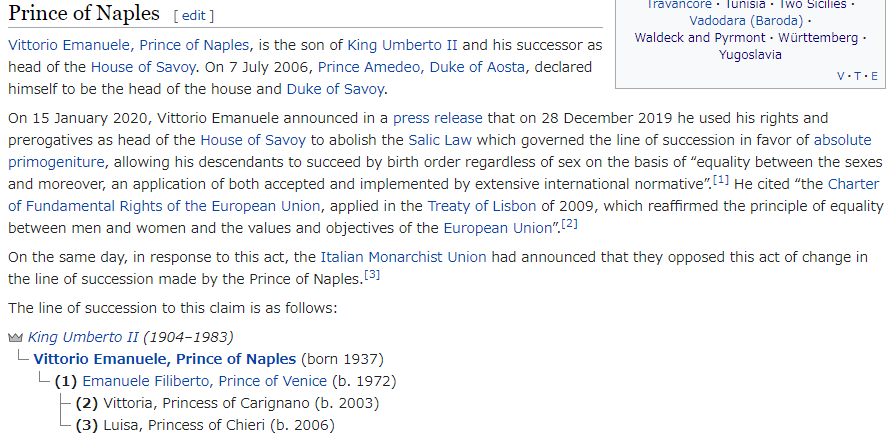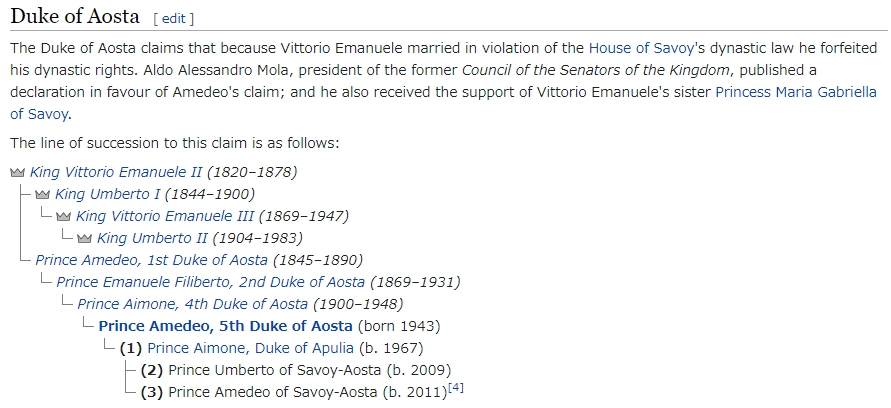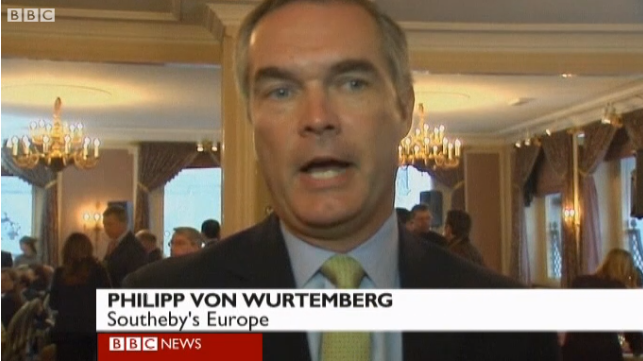note:
As of August 2020.
See also:
Line of succession to the former Monarchical throne and others : From (deleted) Wikipedia’s articles.
The Italian monarchy was abolished in June 1946 following a referendum which established a republic. The present pretenders are Vittorio Emanuele, Prince of Naples and Prince Amedeo, Duke of Aosta, who dispute each other’s right to the throne.
Prince of Naples
Vittorio Emanuele, Prince of Naples, is the son of King Umberto II and his successor as head of the House of Savoy. On 7 July 2006, Prince Amedeo, Duke of Aosta, declared himself to be the head of the house and Duke of Savoy.
On 15 January 2020, Vittorio Emanuele announced in a press release that on 28 December 2019 he used his rights and prerogatives as head of the House of Savoy to abolish the Salic Law which governed the line of succession in favor of absolute primogeniture, allowing his descendants to succeed by birth order regardless of sex on the basis of “equality between the sexes and moreover, an application of both accepted and implemented by extensive international normative”.[1] He cited “the Charter of Fundamental Rights of the European Union, applied in the Treaty of Lisbon of 2009, which reaffirmed the principle of equality between men and women and the values and objectives of the European Union”.[2]
On the same day, in response to this act, the Italian Monarchist Union had announced that they opposed this act of change in the line of succession made by the Prince of Naples.[3]
The line of succession to this claim is as follows:
- King Umberto II (1904–1983)
- Vittorio Emanuele, Prince of Naples (born 1937)
- (1) Emanuele Filiberto, Prince of Venice (b. 1972)
- (2) Vittoria, Princess of Carignano (b. 2003)
- (3) Luisa, Princess of Chieri (b. 2006)

Duke of Aosta
The Duke of Aosta claims that because Vittorio Emanuele married in violation of the House of Savoy’s dynastic law he forfeited his dynastic rights. Aldo Alessandro Mola, president of the former Council of the Senators of the Kingdom, published a declaration in favour of Amedeo’s claim; and he also received the support of Vittorio Emanuele’s sister Princess Maria Gabriella of Savoy.
The line of succession to this claim is as follows:
- King Vittorio Emanuele II (1820–1878)
- King Umberto I (1844–1900)
- King Vittorio Emanuele III (1869–1947)
- King Umberto II (1904–1983)
- Prince Amedeo, 1st Duke of Aosta (1845–1890)
- Prince Emanuele Filiberto, 2nd Duke of Aosta (1869–1931)
- Prince Aimone, 4th Duke of Aosta (1900–1948)
- Prince Amedeo, 5th Duke of Aosta (born 1943)
- (1) Prince Aimone, Duke of Apulia (b. 1967)
- (2) Prince Umberto of Savoy-Aosta (b. 2009)
- (3) Prince Amedeo of Savoy-Aosta (b. 2011)[4]

Line of succession in June 1946
- King Carlo Alberto of Sardinia (1798–1849)
- King Vittorio Emanuele II (1820–1878)
- King Umberto I (1844–1900)
- King Vittorio Emanuele III (born 1869)
- King Umberto II (born 1904)
- (1) Vittorio Emanuele, Prince of Piedmont (b. 1937)
- Prince Amedeo, Duke of Aosta (King Amadeo I of Spain) (1845–1890)
- Prince Emanuele Filiberto, Duke of Aosta (1869–1931)
- (2) Prince Aimone, Duke of Aosta (b. 1900)
- (3) Prince Amedeo, Duke of Apulia (b. 1943)>[5]
- (4) Prince Vittorio Emanuele, Count of Turin (b. 1870)
- Prince Ferdinando, Duke of Genoa (1822–1855)
- Prince Tommaso, Duke of Genoa (1854–1931)
- (5) Prince Ferdinando, Duke of Genoa (b. 1884)
- (6) Prince Filiberto, Duke of Pistoia (b. 1895)
- (7) Prince Adalberto, Duke of Bergamo (b. 1898)
- (8) Prince Eugenio, Duke of Ancona (b. 1906)
The dukes of Genoa male line ultimately became extinct upon the death of Prince Eugenio, the last surviving male agnate of this line, in 1996. In turn, this left only the main Savoy royal male line and the Savoy-Aosta male line.
Clashes
On 21 May 2004 blows were struck in Madrid between the Crown Prince and the Duke of Aosta. At a soirée held at the Zarzuela Palace during the wedding celebrations of the Prince of Asturias, Amedeo approached Vittorio who reportedly punched him twice in the face, causing him to stumble backward down the steps.[6][7] The quick intervention of Queen Anne-Marie of Greece, who propped him up, prevented the Duke from falling to the ground.[7] She discreetly assisted him indoors while staunching his bleeding face until first aid was administered.[6] Upon learning of the incident, King Juan Carlos of Spain reportedly declared that “never again” would an opportunity to abuse his hospitality be afforded the competing pretenders.[6][7] The Queen’s quick action avoided what might have been more serious injury to Amedeo and a public escalation of the confrontation.
In response to the Duke of Aosta’s attempt in 2006 to assume the headship of the house, and his and his son’s assumption of the name “di Savoia” along with the undifferenced arms of the Royal House of Savoy and of the Prince of Piedmont, the Prince of Naples and his son filed a lawsuit against the Aosta branch. The lawsuit was successful, the court of Arezzo ruling in February 2010 that the Duke of Aosta and his son must pay damages totalling 50,000 euros to their cousins and cease their use of the arms of the Royal House and those of the Prince of Piedmont.[8] They were also forbidden to use the name “di Savoia”, instead they must resume the name “di Savoia-Aosta”.[9] The Duke of Aosta is appealing the ruling.[10]


